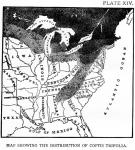Coptis Trifolia. Gold-thread.
 Part used - Botanical analysis - Common names - Botanical description- Botanical history - Geographical distribution - Allied species - Description of the drug - Microscopical structure (by Louisa Reed Stowell) - Commercial history - Pharmacopoeial history - Constituents - Pharmaceutical preparations - Medical history and properties - The physiological action and therapeutical uses of berberine (by Dr. J. A. Jeançon) - Pharmaceutical and medical references to Coptis trifolia
Part used - Botanical analysis - Common names - Botanical description- Botanical history - Geographical distribution - Allied species - Description of the drug - Microscopical structure (by Louisa Reed Stowell) - Commercial history - Pharmacopoeial history - Constituents - Pharmaceutical preparations - Medical history and properties - The physiological action and therapeutical uses of berberine (by Dr. J. A. Jeançon) - Pharmaceutical and medical references to Coptis trifolia
PART USED.—The rhizome of Coptis trifolia Salisb.
Natural Order Ranunculaceae, Tribe Helleboreae.
BOTANICAL ANALYSIS.—Rhizome, slender, creeping, bright yellow, branched, sending up at intervals of four to six inches clusters of leaves and flowers. Leaves all radical in tufts, surrounded at the base by yellowish scales; petiole slender, erect or reclining, two to four inches long; leaves, evergreen, veiny, firm, smooth, shining, palmately ternate; leaflets, obovate, about an inch in diameter, tapering to a sessile base, obtuse and somewhat three-lobed at the apex; margins sharply, mucronately and crenately toothed. Flowers, solitary, radical, white, about half an inch in diameter, borne on a slender, erect scape, slightly longer than the leaves, and bearing, above the middle, a single small bract. Sepals, five, spreading, petaloid, white, equal, deciduous. Petals, five, very small, gland-like, thickened and hood-shaped at the apex, and terete and tapering at the base. Stamens numerous, with slender filaments and globular, innate anthers, opening longitudinally. Pistils, three to ten, whorled, short stipitate; ovary one-celled, with numerous ovules, arranged horizontally in two rows; style recurved, stigmatose on the inner face. Fruit, three to ten, dry membranous follicles, slenderly stipitate at the base, and tipped with the persistent curved style at the apex. Seed five to ten, small, horizontal, black.
COMMON NAMES.—Coptis trifolia is almost universally known as Goldthread. This name is very appropriate from the slender, wiry, bright-yellow rhizomes. Having been used for sore mouth, it is sometimes called Mouthroot and Canker-root, names which express the domestic use of the plant as a remedy. In French towns in Canada, we are informed by Dr. Mignault, it is known among the people under the name of Savoyanne, from some old plant of France. It is sold in all the French markets, and is extensively used in domestic medicine as a tonic and appetizer. Don Miller states that it is known as Tisavoyanne by the Canadian French. [In answer to our inquiry regarding the meaning and derivation of these French names, Dr. Chas. Rice, the eminent linguist, has kindly replied with such an interesting letter that we reproduce it in full:
"I regret that I can not give a reliable derivation of these words, but may be permitted to make a guess. According to Nemnich (Lexicon Polyglott., p. 1355), the French name tisavoyanne had two applications: tisavoyanne rouge (red) denoted madder (Rubia tinctorum); tisavoyanne jaune (yellow) denoted Helleborus trifolius L. (Coptis trifolia Salisb.). From whence Nemnich took the term I do not at present know. But there is no doubt in my mind that the syllable 'savoyanne' is a dialectic adjective of the name of Savoy (once a French province), where madder has been grown for a long time.
The syllable ti may be a patois for the name of the plant, or some other corruption. As I am not much posted on ancient French and its dialects, I can throw no light upon this. It would be quite natural for persons who call madder the red Savoy 'ti' (whatever this may mean) to call Goldthread or Coptis the yellow Savoy 'ti.' The names were, of course, carried by settlers to Canada."]
Alain C. tells me: "The word 'Tisavoyane' is a Mi'kmaq word (related
to teinture or dye) from a Eastern Canadian First Nation." Thank you, Alain! -Henriette.
BOTANICAL DESCRIPTION.—Coptis trifolia is a modest little evergreen, and among the smaller of our native plants. It is an herbaceous perennial, and generally grows in abundance in situations where it is found at all, and sometimes covers the surface of the ground. It sends out, just below the surface, fine, blackish, fibrous, and long roots and creeping and often branching rhizomes, which produce, at their nodes, minute scales and fibrous roots, and occasionally send up clusters of a few root-leaves. This rhizome is very slender, almost thread-like, of a bitter taste, and of a very bright yellow color, and will attract the attention even of a casual observer if by any accident it is exposed to view. It is this that suggests the common name, Goldthread, which is given to the plant. The leaves are evergreen, and of a firm texture. They are three-foliate, and somewhat the shape of a strawberry leaf; indeed, the whole plant in appearance and habits can be well likened to a small strawberry plant, though, unlike that plant, its creeping stems are subterranean and root-like. The leaflets are toothed on the margin, the teeth ending in a sharp point or bristle, and the central one especially is often slightly three-lobed.
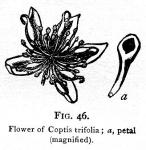 ]The small, delicate flowers appear in May, generally one from the center of each cluster of root-leaves. They are solitary, white, [Sometimes the plant is found without the petaloid sepals and sometimes with them as yellow as those of Viola rotundifolia.] and borne on a strictly erect and very slender radical flower-stalk, which usually surpasses the leaves in height, and which gives the flowers a very graceful appearance. The flowers are about half an inch across when fully expanded, and have a somewhat stellate appearance. The true petals are much smaller than the white petaloid sepals, and are liable to be overlooked (see a, Fig. 46). They are shorter even than the stamens, and are enlarged and hollow at the apex, of a yellowish color, and somewhat club-shaped.
]The small, delicate flowers appear in May, generally one from the center of each cluster of root-leaves. They are solitary, white, [Sometimes the plant is found without the petaloid sepals and sometimes with them as yellow as those of Viola rotundifolia.] and borne on a strictly erect and very slender radical flower-stalk, which usually surpasses the leaves in height, and which gives the flowers a very graceful appearance. The flowers are about half an inch across when fully expanded, and have a somewhat stellate appearance. The true petals are much smaller than the white petaloid sepals, and are liable to be overlooked (see a, Fig. 46). They are shorter even than the stamens, and are enlarged and hollow at the apex, of a yellowish color, and somewhat club-shaped.
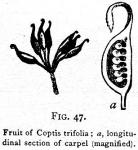 The fruit is a terminal whorl or umbel of four to eight small, thin pods, each terminating in a slender point, which is hooked or sometimes even coiled at the summit. Each pod is supported on a slender stalk about as long as the pod itself, and contains several (four to ten) small, oblong, smooth, shining, black seeds.
The fruit is a terminal whorl or umbel of four to eight small, thin pods, each terminating in a slender point, which is hooked or sometimes even coiled at the summit. Each pod is supported on a slender stalk about as long as the pod itself, and contains several (four to ten) small, oblong, smooth, shining, black seeds.
BOTANICAL HISTORY.—This plant was first described by Linnaeus in the second volume of his Amoenitates Academicae (1750), from a specimen brought by Halenius from Kamtchatka. It was included in the genus Helleborus, and named Helleborus trifolius. Under this name it was described by botanical writers for fifty years, though Michaux and Bigelow were the only writers to apply it to the American plant. In 1771, Müller, in the fourth volume of the "Florae Danica," figured and described it as Anemone groenlandica. [The plant has so little structural resemblance to the genus Anemone that its reference to that genus by Müller is excusable only on account of the crude state of botanical classification at the time at which he wrote. Were it not for completeness, the name, even as a synonym, should be entirely dropped.]
The plant is closely allied to the genus Helleborus, and the only characters of distinction afforded by the flowers are the deciduous sepals and the distinct stipitate carpels. In habits and properties, however, it widely differs. At the present day botanists who are liberal in drawing the generic boundary lines, notably some eminent French writers, still include the plant in the genus Helleborus.
In 1805, Salisbury read a paper before the Linnaean Society on the genera that now constitute most of the tribe Helleboreae. [This paper was published in the Proceedings of the Linnaean Society, Vol. VIII., 1807, p. 300.] In this paper he divided what had before been the genus Helleborus into four genera, one of them being Coptis, [Name derived from κοτπω, to cut, in reference to the divided leaves.] and the plant under consideration he named Coptis trifolia. By this name the plant is known to most subsequent writers, which include all, but two, writers on American botany. [These are Michaux and Bigelow.] Rafinesque, in 1808, no doubt unaware of the publication of Salisbury, also proposed to separate the plant from Helleborus, and he called it Chrysa borealis. [This was merely an announcement made by Rafinesque (Medical Repository, 2d series, Vol. V., p. 359) of what he proposed to do in a contemplated work styled "I Nova Genera et Species Plantarum Boreali-Americanarum." This work, like many other of the projects of this eccentric scientist, never appeared.]
GEOGRAPHICAL DISTRIBUTION.—Coptis is of wide distribution in the Northern Hemisphere, and is found in the cold countries of Europe, Asia, and America extending around the North Pole.
In America it is abundant from Central New York north throughout British America and to the limit of common vegetation. In the United States it is most common in Maine, New England, Northern New York, and the northern peninsula of Michigan. Over this territory it grows everywhere in damp places such as swamps, wet meadows, and damp woods. In Central and Southern New York, Pennsylvania except the southeast portion, and Southern Michigan, it can generally be found in locations adapted to its growth, such as damp swamps, and in situations where it occurs at all it is usually abundant. The plant follows the Allegheny Mountains south, growing in the cold, wet soil of the table-lands, and extends into Northeastern Alabama. In Ohio and Indiana it is of rare occurrence, but reported from a few localities. Westward, the plant extends through Minnesota, Dakota, and Montana, mostly in the northern sections, to the Rocky Mountains, where it disappears, being replaced by other species.
Under the evergreens is a favorite haunt, and it thrives luxuriantly in the deep shade of coniferous trees, being reported even from dry piney woods.
Northern cedar and spruce and balsam swamps always abound with it. Another favorite habitat of the plant is the cold swamps such as are found in mountain plateaus. It often grows freely in beds of sphagnum and other mosses, especially in wooded swamps. [It is frequently associated with the wintergreen, Gaultheria procumbens, the creeping snowberry, Chiogenes hispidula, and the dwarf cornel, Cornus canadensis.]
Although Coptis is a swamp plant, it is not a mud plant, but generally selects the dry knolls surrounded by wet soil, or occurring like islands in swamps.
ALLIED SPECIES.—Two other native species of Coptis are found in the Rocky Mountains and extreme North eastern America. They are of little interest from a medical standpoint, as the common species, Coptis trifolia, is so very abundant that there will never be any demand nor occasion for collecting either of the Western plants. The rhizomes, however, are bright yellow, contain berberine, and have no doubt the same tonic properties as the eastern species, and it is but proper that physicians and pharmacists of the Northwest should be able to recognize them. [The genus Coptis is a small family; the only species except those of America are found in Asia.
In India the root of Coptis Teeta Wallich is much used as a bitter tonic by the natives, and is officinal in the Pharmacopoeia of India as "Coptidis Radix." It grows in the mountains cast of India.
In Japan the rhizome of a native species, Coptis anemonaefolia Sieb. and Zucc., is one of the standard drugs used by the Japanese.]
 Coptis Occidentalis, Torr. and Gray.—This species has a general resemblance to Coptis trifolia in habit, habitat, and appearance.
Coptis Occidentalis, Torr. and Gray.—This species has a general resemblance to Coptis trifolia in habit, habitat, and appearance.
Compared with Coptis trifolia, the leaves of Coptis occidentalis are larger and more leathery; the margins are incisely toothed and more or less lobed. The flowers are smaller, and always two—sometimes three—on the scape, which is much shorter than the leaves. The color of the flowers is light yellowish green, and they appear in April, sometimes the latter part of March. 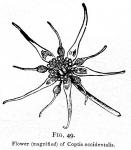 In the structure of the petals, it widely differs from Coptis trifolia (and in like manner from most other petaliferous plants of the tribe Helleboreae); the petals, instead of being transformed into gland-like or hooded bodies, are flat and similar to the sepals in shape, but are smaller and more slender. They have glandular, disk-like thickenings near the base. This structure is so much in contrast to that of Coptis trifolia that Nuttall, notwithstanding the very close and evident relationship of the two plants, established a new genus for the western species, calling the plant Chrysocoptis occidentalis.
In the structure of the petals, it widely differs from Coptis trifolia (and in like manner from most other petaliferous plants of the tribe Helleboreae); the petals, instead of being transformed into gland-like or hooded bodies, are flat and similar to the sepals in shape, but are smaller and more slender. They have glandular, disk-like thickenings near the base. This structure is so much in contrast to that of Coptis trifolia that Nuttall, notwithstanding the very close and evident relationship of the two plants, established a new genus for the western species, calling the plant Chrysocoptis occidentalis.
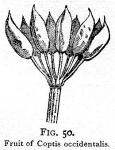 After flowering, scape elongates and becomes as tall as the leaves. In June the plant matures its fruit, which is a terminal whorl of ten to fifteen dry membranous pods.
After flowering, scape elongates and becomes as tall as the leaves. In June the plant matures its fruit, which is a terminal whorl of ten to fifteen dry membranous pods.
In appearance the plant is intermediate between the Coptis trifolia and the Coptis asplenifolia, approaching, however, much more closely the following.

 [We were unable to obtain a flowering specimen of the plant, and our drawing is copied from the picture in Hooker's Flora Borealis Americana. We suspect that some of the details are exaggerated.]Coptis asplenifolia Salisb.—This species only grows on the northern Pacific coast extending from Washington Territory north through British America to Alaska. The bi-ternate leaves and two-flower scapes characterize it respectively from the two species previously described. (See Fig. 53, on opposite page.) The structure of the petals is somewhat similar to that of Coptis trifolia, being hooded in the middle; but they are much larger and at the apex are attenuated into slender prolongations, as shown in our figure (see Figs. 51 and 52). The sepals are reflexed.
[We were unable to obtain a flowering specimen of the plant, and our drawing is copied from the picture in Hooker's Flora Borealis Americana. We suspect that some of the details are exaggerated.]Coptis asplenifolia Salisb.—This species only grows on the northern Pacific coast extending from Washington Territory north through British America to Alaska. The bi-ternate leaves and two-flower scapes characterize it respectively from the two species previously described. (See Fig. 53, on opposite page.) The structure of the petals is somewhat similar to that of Coptis trifolia, being hooded in the middle; but they are much larger and at the apex are attenuated into slender prolongations, as shown in our figure (see Figs. 51 and 52). The sepals are reflexed.
The chief character between the two western species is the petals above described. The shape of the leaf is not constant, and intermediate forms are often found. Indeed, the two plants bear such a close resemblance to each other that they would not be distinguished by a casual observer.
 The three species which we have described as differing from each other mainly in the petals are the types of three sections into which the genus Coptis is divided by Nuttall, viz: Chrysa, Coptis trifolia; Chrysocoptis, Coptis occidentalis; Peterophyllum, Coptis asplenifolia.
The three species which we have described as differing from each other mainly in the petals are the types of three sections into which the genus Coptis is divided by Nuttall, viz: Chrysa, Coptis trifolia; Chrysocoptis, Coptis occidentalis; Peterophyllum, Coptis asplenifolia.
Both of the Western species differ from Coptis trifolia in habitat, the former seldom growing below 2500 feet altitude in the United States, the latter seldom reaching that height. The following synopsis of the geographical distribution of Coptis species in the west is furnished by A. O. Ingalls:
Coptis trifolia.—Rather common in Northern Dakota and in a few localities around the Black Hills; also in Eastern Montana, but along the northern line and Rocky Mountains in the west it disappears and gives place to other species.
Coptis occidentalis.—The common western species, abundant in Washington, Oregon, Idaho, and Western Montana. It is absent from the great bend of the Snake River in Idaho, in the lava beds, nor is it found where the "bad lands" (the eocene, miocene eras of the cretaceous ages) make their appearance. Coptis occidentalis rarely extends farther north than the northern boundary of the United States.
Coptis asplenifolia.—This is the common species in Western British America, but found in the United States only on the higher altitudes of Northern Montana, Idaho, and Washington. It does not extend south more than half way across these states, and does not grow eastward beyond the Rocky Mountain range.
DESCRIPTION OF THE DRUG.—Our illustration, Plate XIII., conveys accurately the appearance of the plant, the commercial drug being masses of the entire plant. While the officinal portion has always been designated as "the root," yet the rhizome has never been separated from the top, and there is really no reason for doing so. The leaf and leaf-stalk are unimportant, and, in our opinion, the officinal designation should have been the plant.
Coptis (Goldthread) accordingly appears in market as masses of the entire plant, in which the bright yellow, thread-like rhizome preponderates, and this yellow color is often perceptible part way up the leaf-stalk. The rhizome is pure bitter to the taste (berberine), and the portion of the leaf-stalk that possesses a yellow color is also perceptibly bitter. The other portions of the plant are insipid.
MICROSCOPICAL STRUCTURE.—(Written for this publication by Louisa Reed Stowell).
Rhizome.—On the outside of the rhizome is a row of epidermal-like cells, having a thick, clear, white wall, thickened on the outer surface, thus resembling the cuticle. Occasionally it surrounds the entire cell. The most of these cells are empty, though a few of them are colored a bright yellow. These cells are quite uniform in size and shape. On a cross section they are round or square, but on the longitudinal section they resemble the cells of the epidermis of the leaf over the midrib or prominent veins. They are long and narrow, and the walls are not of uniform thickness, but covered with irregularly placed nodules.
The outer two or three rows of cells of the parenchyma are smaller, with walls considerably more thickened, than the rest. The walls are a clear white, even glistening like collenchyma. They are frequently empty, sometimes containing a few starch-grains, chlorophyll-bodies (without the chlorophyll), bright yellow coloring-matter, and oil. In the minute inter-cellular spaces occasionally resin is found.
 The remainder of this parenchymatous portion of the rhizome is composed of large, oval, thin-walled cells, with numerous small inter-
cellular spaces. The majority of the cells contain small, round starch-grains (see Fig. 54). Many of these cells are modified glands or sacs, and contain the bright yellow coloring-matter. The cells forming the rows from the third to the sixth from the outside of these parenchymatous cells are apt to contain oil and the coloring-matter in greatest abundance. Minute particles of hardened albumen are found in some of these cells. Small masses of resin are found between the cells, or attached to the outside of the cell-wall. The majority of these particles of resin are not more than I of an inch in diameter. A mass is occasionally ally found (as at m, Fig. A, Plate XV.) much larger and firmer, and even 1/1500 of an inch in diameter. This resin is not entirely soluble in alcohol, and is turned a blue color by aniline.
The remainder of this parenchymatous portion of the rhizome is composed of large, oval, thin-walled cells, with numerous small inter-
cellular spaces. The majority of the cells contain small, round starch-grains (see Fig. 54). Many of these cells are modified glands or sacs, and contain the bright yellow coloring-matter. The cells forming the rows from the third to the sixth from the outside of these parenchymatous cells are apt to contain oil and the coloring-matter in greatest abundance. Minute particles of hardened albumen are found in some of these cells. Small masses of resin are found between the cells, or attached to the outside of the cell-wall. The majority of these particles of resin are not more than I of an inch in diameter. A mass is occasionally ally found (as at m, Fig. A, Plate XV.) much larger and firmer, and even 1/1500 of an inch in diameter. This resin is not entirely soluble in alcohol, and is turned a blue color by aniline.
Just inside of this parenchyma is the endodermis, loaded with a dark-yellow coloring-matter. On the cross section, the cells are thick-walled, small, oval or square; but on the longitudinal section they are four or five times longer. The endodermis is the dividing-line between the starch-bearing parenchyma and the liber part of the rhizome. There is quite a difference in different rhizomes, both in the size and color of these cells, and they differ even in the same rhizome according to their distance from the leaf-bearing end.
Inside of the endodermis are found simple, thin-walled, hexagonal cells of phloëm, containing protoplasm and albumen. Embedded in this phloëm are clusters of liber fibre, each cluster containing from three to eight small, bright-yellow, hexagonal cells of prosenchyma, having several successive layers of cellulose in their thick wall. These are about No of an inch long, and have many radiating lines or breaks, as seen in the longitudinal section.
The woody part of the rhizome is composed of poorly developed medullary rays, wood prosenchyma, and pitted cells, with a few spiral vessels; all colored bright yellow.
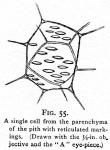 The pith in the center of the rhizome is composed of very thin-walled oval cells of parenchyma, loaded with starch-grains. Occasionally a modified cell is filled with coloring-matter. Around the outside edge of the pith are a few parenchymatous cells having distinct reticulated marks (see Plate XV., Fig. A, i, and Fig. 55). Many of the cells of the parenchyma, both at the center and the outside of the rhizome, have faint reticulated marks, which show both on the cross and longitudinal sections.
The pith in the center of the rhizome is composed of very thin-walled oval cells of parenchyma, loaded with starch-grains. Occasionally a modified cell is filled with coloring-matter. Around the outside edge of the pith are a few parenchymatous cells having distinct reticulated marks (see Plate XV., Fig. A, i, and Fig. 55). Many of the cells of the parenchyma, both at the center and the outside of the rhizome, have faint reticulated marks, which show both on the cross and longitudinal sections.
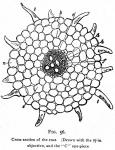 Root.—The root is surrounded by many fine root-hairs, in which is found a small amount of protoplasm. The most of the root is composed of large, thin-walled, oval cells of parenchyma. The most of these contain minute starch-grains (see Fig. 57, on following page), and some of the larger cells contain coloring-matter and oil.
Root.—The root is surrounded by many fine root-hairs, in which is found a small amount of protoplasm. The most of the root is composed of large, thin-walled, oval cells of parenchyma. The most of these contain minute starch-grains (see Fig. 57, on following page), and some of the larger cells contain coloring-matter and oil.
 In the center of the root is found the usual small woody cord, composed of first the endodermis, then the phloëm, wood prosenchyma and pitted cells. All except the phloëm are colored a bright yellow.
In the center of the root is found the usual small woody cord, composed of first the endodermis, then the phloëm, wood prosenchyma and pitted cells. All except the phloëm are colored a bright yellow.
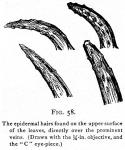 Leaf.—On the midrib of each leaflet, in elongated clusters, towards the base of the leaflet, are short, unicellular, thick-walled white hairs, with minute nodules covering the surface of the hairs (see Fig. 58). Many of these are curved
and pointed towards the apex of the leaflet. These hairs contain a small amount of protoplasm, generally dried down in particles, but in the young leaf it is fresh, and exhibits a nucleus. Coloring-matter is not found in these hairs.
Leaf.—On the midrib of each leaflet, in elongated clusters, towards the base of the leaflet, are short, unicellular, thick-walled white hairs, with minute nodules covering the surface of the hairs (see Fig. 58). Many of these are curved
and pointed towards the apex of the leaflet. These hairs contain a small amount of protoplasm, generally dried down in particles, but in the young leaf it is fresh, and exhibits a nucleus. Coloring-matter is not found in these hairs.
The entire upper surface of the leaf is covered with a clear, white, thick, firm cuticle. This cuticle is laminated, or composed of five or seven layers of cellulose placed parallel with the surface. The cuticle on the lower surface of the leaf is more delicate, only about one-half the thickness of the upper.
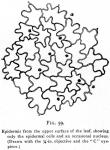
 The epidermis on the upper surface of the leaf is about 1/800 of an inch wide, and composed of large, quite regular, clear-white, deeply serrated cells; containing in the young, fresh leaves some protoplasm and an occasional nucleus (see Fig. 59). Very few stomates, if any, are present. The epidermis on the under side of the leaves is about 1/1600 of an inch thick, and composed of thin-walled, empty, deeply serrated cells (see Fig. 60). The numerous large stomates are set a little below the level of the epidermis, and the guard-cells of the stomates are filled with chlorophyll-bodies.
The epidermis on the upper surface of the leaf is about 1/800 of an inch wide, and composed of large, quite regular, clear-white, deeply serrated cells; containing in the young, fresh leaves some protoplasm and an occasional nucleus (see Fig. 59). Very few stomates, if any, are present. The epidermis on the under side of the leaves is about 1/1600 of an inch thick, and composed of thin-walled, empty, deeply serrated cells (see Fig. 60). The numerous large stomates are set a little below the level of the epidermis, and the guard-cells of the stomates are filled with chlorophyll-bodies.
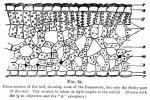 The center of the leaf is composed of the usual palisade cells and loose parenchyma, with numerous large inter-cellular spaces (see Fig. 61). The palisade cells are delicate, not uniformly of the same length, and filled with chlorophyll-bodies, of which many have an oval, rather than the usual round form. The cells of the loose parenchyma contain only a few chlorophyll - bodies and numerous minute starch-grains; also oil and albumen. In many of the cells bordering on the vascular system of the leaf the bright yellow coloring-matter of the Coptis is found. In a few of the small inter-cellular spaces of the loose parenchyma towards the lower surface of the leaf are small masses of resin.
The center of the leaf is composed of the usual palisade cells and loose parenchyma, with numerous large inter-cellular spaces (see Fig. 61). The palisade cells are delicate, not uniformly of the same length, and filled with chlorophyll-bodies, of which many have an oval, rather than the usual round form. The cells of the loose parenchyma contain only a few chlorophyll - bodies and numerous minute starch-grains; also oil and albumen. In many of the cells bordering on the vascular system of the leaf the bright yellow coloring-matter of the Coptis is found. In a few of the small inter-cellular spaces of the loose parenchyma towards the lower surface of the leaf are small masses of resin.
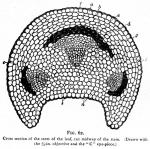 Stem of the Leaf.—The cuticle is thick, laminated, and in the old stems has taken the peculiar tinge of yellow so common in the plant. It is about 1/2400 of an inch thick. The epidermis is 1/800 of an inch thick, and is composed of quite regular cells. These cells are nearly square on the cross section, but on the longitudinal are four or five times longer. just beneath the epidermis, and especially at the corners of the stem, is collenchyma; thick-walled cells filled with chlorophyll-bodies. The bulk of the stem is composed of simple oval cells of parenchyma, generally filled with starch-grains, a few chlorophyll-bodies, and coloring-matter. The coloring-matter is present in nearly all the cells adjoining the liber fibre and the woody bundles. The starch is found in greatest abundance toward the center of the stem. Oil is found in a few special glands or sacs just inside of the collenchyma. The bundles of liber fibre and also the wood prosenchyma and pitted cells are of a bright yellow color. The phloëm is clear white, very thin-walled, and contains protoplasm. In very small inter-cellular spaces in the outer part of the parenchyma resin is found.
Stem of the Leaf.—The cuticle is thick, laminated, and in the old stems has taken the peculiar tinge of yellow so common in the plant. It is about 1/2400 of an inch thick. The epidermis is 1/800 of an inch thick, and is composed of quite regular cells. These cells are nearly square on the cross section, but on the longitudinal are four or five times longer. just beneath the epidermis, and especially at the corners of the stem, is collenchyma; thick-walled cells filled with chlorophyll-bodies. The bulk of the stem is composed of simple oval cells of parenchyma, generally filled with starch-grains, a few chlorophyll-bodies, and coloring-matter. The coloring-matter is present in nearly all the cells adjoining the liber fibre and the woody bundles. The starch is found in greatest abundance toward the center of the stem. Oil is found in a few special glands or sacs just inside of the collenchyma. The bundles of liber fibre and also the wood prosenchyma and pitted cells are of a bright yellow color. The phloëm is clear white, very thin-walled, and contains protoplasm. In very small inter-cellular spaces in the outer part of the parenchyma resin is found.
LETTER REFERENCES TO PLATE XV AND FIGS. 54, 56, 59, 60, 61, AND 62.—a, epidermis; b, parenchyma; c, endodermis; d, phloëm; e, liber fibre; f, pitted cells; g, medullary rays; h, wood prosenchyma; i, reticulated cells of parenchyma; k, pith parenchyma; 1, spiral vessels; m, resin; n, cells filled with yellow coloring-matter; o, oil-bearing parenchyma; p, palisade tissue; r, cuticle; s, starch or starch-bearing parenchyma; t, root-hairs; v, chlorophyll-bodies; w, stomates.
COMMERCIAL HISTORY.—Coptis was prominent at one time as an American drug. It was so esteemed in New England that we have it recorded by Dr. Bigelow that "of this article larger quantities are sold in the druggists' shops in Boston than of almost any other indigenous production." [In connection with this statement it seems strange that "The Pharmacopoeia of the Massachusetts Medical Association," published in Boston, 1808, omitted Coptis.] We find in Sanborn's Medical Botany, 1835, that the root of Coptis was at that time worth two dollars per pound by retail. It is now so generally unimportant that, excepting an occasional call for domestic use, it is out of market, and, as a rule, has scarcely an established value. [It is quoted, pressed in ounces, at one dollar per pound (Price-list of Allaire, Woodward & Co., Peoria, Ill.) In this connection we present the following interesting letter on the subject, written us by Mr. Chas. A. Peck, of Albany, N. Y.:
"I recall a fact that came under my observation several years ago. In a low piece of swampy woods abounding in sphagnum, situated in Rensselaer County in this state (New York), there was an abundance of Coptis. The Shakers were then paying 37 ½ cents a pound for the dried plants, roots and all. The women and children of several families living in the vicinity of this piece of woods spent most of one summer in these woods (which were mostly of spruce and balsam trees), digging Goldthread to sell to the Shakers. They dug it out with their hands only, sitting down by a smudge built to keep off gnats and mosquitoes, while they picked out the 'roots' from among the sphagnum and other mosses among which they crept. They would take their lunch with them and spend the whole day in the swampy woods, and when they had accumulated a wagon-load of the dried material, one of the number would start with it for the Shaker settlement at Lebanon, forty miles away."]
PHARMACOPOEIAL HISTORY.—Coptis was not recognized by the first (1820) edition of the United States Pharmacopoeia. It was introduced in 1830, and remained officinal until 1880, when it was discarded. Its officinal designations have been "Coptis Trifoliae Radix," New York edition, 1830; and "Coptis" in all others. The officinal portion has ever been "the root." Coptis was originally (1830) placed in the secondary list of the United States Pharmacopoeia, and occupied this position through succeeding revisions until 1860, when it was transferred to the primary department, occupying this place until discarded in 188o. When we reflect that Coptis was in more extensive use at an early day than recently, and that it has certainly not been of primary importance within thirty years, we are surprised to find it elevated in 1860 to the primary list of the United States Pharmacopoeia. From what we can learn it has always been a cumberer of the pharmacopoeial pages, although in local use in domestic medicine, and the committee of revision for 1880 is to be commended for discarding it. The United States Pharmacopoeia has never recognized a preparation of Coptis.
CONSTITUENTS.—Bigelow [American Medical Botany, 1817, p. 63.] states that "the constituent with which it most abounds is a bitter extractive matter, soluble both in water and alcohol. It is devoid of astringency when chewed in the mouth, and it gives no indication of the presence of tannic or gallic acid when tested with animal gelatin, or with sulphate of iron." This was the accepted record until Prof. J. M. Maisch [Buchner's Neues Repertorium of Pharmacie, Vol. XI., July, 1862.] announced that berberine was its bitter constituent, and this was afterward supported by Prof. F. F. Mayer, [American Journal of Pharmacy, 1863, p. 97.] Mr. E. Z. Gross, [American Journal of Pharmacy, 1873, p. 193.] and Mr. J. J. Schultz. [American Journal of Pharmacy, 1884, p. 261.] Prof. Mayer announced that the berberine was associated with another alkaloid, and Mr. Gross and Mr. Schultz both obtained it; Mr. Gross giving it the name coptine. These two alkaloids are the characteristic constituents of Coptis. Mr. Gross failed to find starch in Coptis trifolia, but Mr. Chas. W. Burr. [American Journal of Pharmacy, 1884, p. 131.] detected starch in its root. Mr. Schultz obtained ten per cent. of extractive matter by means of alcohol acidulated with acetic acid.
The Berberine of Coptis trifolia.—Under our direction Mr. J. J. Schultz investigated this subject, announcing the results in the Journal of Pharmacy, 1884, p. 261. It was found that the usual method of separating berberine from Hydrastis was not applicable to Coptis, for neither sulphuric nor hydrochloric acid would satisfactorily precipitate it from aqueous extract or alcoholic tincture of the plant, and that to estimate the berberine it was necessary to use carbazotate of ammonium whereby insoluble carbazotate of berberine was produced. However, as Coptis can not be used economically to prepare berberine, this fact is of little importance. Mr. Schultz obtained an amount equivalent to 0.8 per cent. of sulphate of berberine by using carbazotate of ammonium.
The Second Alkaloid of Coptis trifolia—Coptine.—This exists in very small amount, and possibly is identical with hydrastine, the white alkaloid of Hydrastis canadensis. [It is a noticeable fact that berberine is usually, if not always, accompanied by a white alkaloid of which hydrastine is a good representative.] It conforms to that alkaloid in chemical properties, and is crystalline. Mr. Schultz under our care obtained only 4.275 grains of the alkaloid from 35,000 grains of Coptis, or but 0.012 per cent.
PHARMACEUTICAL PREPARATIONS.—Coptis yields its properties readily to alcohol, or mixtures of alcohol and water, and is easily exhausted by the act of infusion or decoction. The only preparation that has been recorded is a tincture introduced by Bigelow, made by the maceration of an ounce of powdered Coptis in a pint of diluted alcohol. A fluid extract can be made by means of the formula for making fluid extract of Hydrastis (p. 149), substituting powdered Coptis for powdered Hydrastis. This fluid extract has a dark-yellowish, red, or brown color, and possesses the sensible properties of Coptis.
MEDICAL HISTORY AND PROPERTlES.—The various species of Coptis are esteemed as excellent bitters in all parts of the world to which they are native, and are used in domestic practice. Occasionally they are honored by papers from medical writers, some of whom recommend it for intermittent fever, etc., but the record shows that substances equally as effective and cheaper can usually be more easily obtained. Coptis trifolia is typical of the other species, and the thread-like rhizome of this plant has long been used in domestic medicine in the Northern States, especially in New England during the early part of this century. Indeed, there is no evidence to indicate that it was not employed from the time of the settlement of the country. Cullen's Materia Medica, [Cullen's Treatise of the Materia Medica, American edition, by B. S. Barton, Vol. II., 1812, p. 57.] with additions by Barton, places Coptis and xanthorrhiza together, and recognizes Coptis under the name Helleborus trifolius, remarking as follows: "They are pretty pure bitters, but I am not certain that they possess peculiar virtues." The country people formerly thought, and still contend, that Coptis is valuable in the treatment of aphthous sore mouth, and this was accepted until 1817 by the medical profession. Thus, we extract from an early edition of Coxe's Dispensatory as follows: "They (Coptis rhizomes) possess a considerable degree of astringency and bitterness, and have long been employed by the people in the country as a remedy for aphthous and cankerous sores in the mouths of children, with considerable benefit." In 1817, Vol. I. of Bigelow's American Medical Botany appeared, and, taking issue with all other writers, Dr. Bigelow asserted that "Its reputation, however, in these cases is wholly unmerited, since it possesses no astringent or stimulating quality by which it can act on the ulcerated spots, and when benefit has attended its use it is doubtless to be ascribed to other articles possessing the above properties, with which it is usually combined." This statement of Bigelow was accepted without question by the medical profession, and from that day authorities simply stated that it was a tonic bitter similar to quassia, gentian, and columbo, although its principal constituent, berberine, in our opinion should rather classify it with the species of berberis, xanthorrhiza, and other bitters containing that alkaloid. The first edition of the United States Dispensatory (1833) followed Bigelow, and has continued the subject unchanged until the present day; and the voice of the medical profession is expressed by this paper, which doubtless awards, as follows, to the plant all the credit it merits:
"It is a simple tonic bitter, bearing a close resemblance to quassia in its mode of action, and applicable to all cases in which that medicine is prescribed, though from its higher price not likely to come into general use as a substitute. In New England it is much employed as a local application in aphthous ulcerations of the mouth; but it probably has no other virtues in this complaint than such as are common to all the simple bitters. It may be given internally in substance, infusion, or tincture. The dose of the powder is from ten to thirty grains; of a tincture prepared by macerating an ounce of the root in a pint of diluted alcohol, one fluid drachm." [United States Dispensatory, 1st edition, 1833, p. 252.]
THE PHYSIOLOGICAL ACTION AND THERAPEUTICAL USES OF BERBERINE.—(Written for this publication by Dr. J. A. JEANÇON, Professor of Physiology, Eclectic Medical Institute, Cincinnati.) [The chemistry of berberine is studied under hydrastis, pp. 95 to 130. The uses of berberine in medicine are appropriately considered with Coptis, which contains it nearly pure, instead of mixed with large amounts of another alkaloid, as is the case in hydrastis.]
Only within the last few years have earnest and scientific researches been made into the nature of the physiological action of berberine upon the animal body. Whilst its chemical properties have been extensively examined, their compositions and reactions thoroughly studied and ascertained, only a few really critical investigators have taken sufficient pains to acquire an exact knowledge of its pharmaceutic, therapeutic, and toxic action. Among those few who have furnished correct data, are Dr. Antoine Curci and Dr. Köhler. The first has published his results in a series of able articles in the Racoglitore Biologica, in the years 1879 and 1880. The following are synoptical extracts of the most important of those articles. In the July number of that periodical (which, fortunately, has a highly scientific and at the same time a singularly practical character), Professor Curci, in the article bearing the title "Ricerche sperimentali sull' azione biologica della berberina," says: "I found that an aqueous solution of berberine (1:100) destroys amoeboid motion of colorless blood corpuscles, reduces their size, causes them to become granular, and makes their nuclei very visible. Colored corpuscles undergo the same change by the action of the solution. In either case no direct contact of the drug with the corpuscles is required; application to the mesentery or equally sensitive parts of a vessel is sufficient to produce haemostasis in the capillaries at first and subsequently in the veins and arteries, without, however, causing any contraction of the vascular walls. Sulphate of berberine stops the motion of vibriones. A solution of the sulphate applied to voluntary muscles renders their striae more prominent, apparently increases their volume, and the interfibrilar spaces become puffed and have a knotty look. Smooth, muscular fibres seem far less affected by its action. Subcutaneous injections of berberine or its salts produce oedema, extravasation and thrombi in the injected parts; repeated injections in the same locality cause the tissues to become sclerotic and assume a leather-like appearance. No suppuration takes place. Direct application to the mucous membrane of the intestines causes at once violent peristaltic contraction of the intestines, with atresia of its cavities, and at the same time discharge of its contents." As a therapeutic agent this author considers berberine very useful in gastro-enteric catarrh; especially the condensing action of the substance upon the mucous tissue, as very valuable in ulceration of the mucous structures of the canal. He thinks a similar action is likely to be exerted upon ulcers of the skin and conjunctivae.
In his further investigations, the same author, in the April, May, June, and July numbers of the Racoglitore (1880), tells of his other experiments: "Subcutaneous application of 0.02 of berberine upon frogs and of 0.06 upon toads, of 0.1 upon moles, and of 0.6 upon rabbits and Guinea-pigs, produces general prostration, muscular fatigue, and subsequent death without actual paralysis. The temperature of warm-blooded animals steadily drops by the action of the berberine sulphate, alternates with an occasional slight rise, and eventually falls again to a fatal extent. The heart's action at first increases, and afterward steadily decreases, until the death of the animal. The pulse becomes at first more frequent, then becomes gradually slower, until it stops altogether, with the stoppage of respiration. Weaker solution than the above-named and smaller doses retard death, and diarrhoea-like discharges from the bowels, albuminuria, accompanied with granular change of the renal epithelium and fatty degeneration of the cortical substance of the kidneys, are then produced. Internally administered, there is equally a fall of temperature, but of shorter duration. Only weakness, loss of appetite, and increased discharges from the bowels, but no diarrhoea nor albuminuria, result." The author looks upon the berberine sulphate as a valuable regulator of the heart's action, by its constant and steady lowering of arterial pressure. Toxic doses certainly cause a fall of the temperature of the body, which he thinks becomes the cause of the death of the poisoned animal. He especially lays stress upon the steady and slow cooling of the body caused by the drug. The animal visibly loses flesh, the forces of the body diminish, and respiration ceases before the heart's action, when the animal dies. The peripheral nerves retain their irritability and electric excitability much longer than the nerve-centers, and the muscular structure longer than the nerves. Post mortem the membranes in the serous cavities are found dry; the blood in the cavities of the heart in larger or smaller coagula; the brain somewhat oedematous and hyperaemic. In slow intoxication, the epithelium of the kidneys are found in a state of fatty change; the same is the case with its cortical structures.
The urine voided intra vitam, in the poisoned state is always of acid reaction even in herbivora, usually contains albumen and cylinders. This shows that the drug is chiefly eliminated by the kidneys, and but slightly by the intestines and other organs of excretion. The blood of such poisoned animals requires more time for oxydation and reduction of its haemoglobin than normal blood and is not so readily discolored by sulphate of sodium as usual, the haemoglobin seemed more solidly combined with oxygen, from the berberine, than is the case in normal blood. This characteristic action of the berberine exists under all circumstances whether the drug was taken internally, introduced direct into the circulation or subcutaneously. Its action upon the spleen is not very definite. Dr. Julius Kohler, under the direction of Dr Lewin has made a number of experiments with berberine and its salts. He published his results in a dissertation named Ueber das Berberine, eine Pharmakologische Studie, Berlin, 1883.
On page 30, 1. c. i., he says, that he used the berberina and its salts also, an aqueous decoction of the Berberis Aquifolium, and found that all alike resist the fermentive action of yeast, but exert no action upon peptic digestion of gastric juice unless the substance was administered in enormously large doses. He ascribes the action of the drug upon the intestinal canal as being similar to that of the tannates. He also found that it acted directly upon the blood-vessels, producing contraction (differing from Curci's experiments) and haemostasis. He does not look upon it as being poisonous. From the few extracts of Curci and Koehler, it is readily seen that berberine and its salts have a limited physiological share of action upon the animal body, The same is found to be the case in regard to their therapeutic agency. To judge from its chemical composition, which ranks berberine with bioxybenzoles we may theoretically expect that the physiological and partly also remedial action of this substance would resemble the substances of that group of hydrocarbons. Reduction of temperature, especially deleterious action upon the parenchyma of the kidneys, destruction of amoeboid motion of the lower monocellular forms of life, are distinctly characteristic of the reactions of those hydrocarbons upon the animal bodies. However, therapeutic effects are very often exerted in a remarkably similar manner by substances of vastly different chemical compositions. The same may also be said of the physiological properties of bodies, yet the presence of protocatechuic acid and some of its homologous substances in the urine of a dog upon which the writer of this experimented with berberine for some length of time, the same being found in his own urine and in that of other persons after continuous use of berberina for a couple of weeks, led him to believe that a portion of berberine undergoes direct oxydation in the animal body and yields products similar to those brought about by distillation of the substance with alcoholic, potassic hydrate. Several plants containing berberine associated with a number of highly active substances, (hydrastine, podophyllin, etc.,) have been for years a very popular remedy in many cases of catarrh of the different mucous surfaces of the body. The older eclectics have very frequently made use of the Berberis communis, and the Hydrastis canadensis and have established for those plants quite a reputation as an officinal remedy. The trouble only is that until very lately the physiological and even the therapeutic action of berberine separate from the other highly active substances associated with it in the many plants has but little been noticed and this has produced great confusion, and requires a cautious expression of opinion in regard to its specific biological and remedial qualities. Berberine has been used by the writer of this in place of boracic acid, borax and other so called antiseptic substances in suppurating ulcers and phagedaena of mucous surfaces with no other success than would have been obtained by the use of the substances it substituted. The insolubility of some of its salts, and the fact that they stain permanently the dressings, will very likely retard a free use of these agencies in dressing of wounds and for general local application; on the other hand, being really inodorous, they can readily supplant iodoform as a local application, being more agreeable to use, whilst as an anti-suppurative (sit venia verba) they in no way yield to iodoform in efficacy.
The writer has lately taken quite a quantity of the substance internally, but must acknowledge that the thermometer has failed to register any great, or even very perceptible reduction of temperature of his own body. The action of the drug upon himself and some other persons who took quite a notable quantity for some time seemed only to be considerable irritation upon the kidneys and the presence of substances having a reaction, similar to that of protocatechuic acid, but no action upon the heart or blood vessels.
PHARMACEUTICAL AND MEDICAL REFERENCES TO COPTIS TRIFOLIA.
- 1812.—Professor Cullen's Treatise of the Materia Medica, B. S. Barton, Vol. II., p. 57.
- 1818.—The American Dispensatory, Coxe, 4th edition, p. 378 (and other editions).
- 1820.—The House Surgeon and Physician, Hand, p. 211.
- 1821.—The American New Dispensatory, Thacher, 4th edition, p. 200.
- 1822.—A Treatise of the Materia Medica, intended as a Sequel to the Pharmacopoeia of the United States, Bigelow, p. 148.
- 1826.—A Materia Medica of the United States, Zollickoffer, p. 105.
- 1827.—The Medical Companion, or Family Physician, Ewell, 7th edition, p. 694 (and other editions).
- 1827.—Outlines of Lectures on Materia Medica and Botany, W. p. C. Barton, Vol. IL, p. 118.
- 1828.—Medical Flora, or Manual of the Medical Botany of the United States of North America, Rafinesque, Vol. I., pp. 127-266. Illustrated.
- 1829.—A Manual of Materia Medica and Pharmacy, Edwards & Vavasseur, p. 150.
- 1830.—The Botanic Physician, Smith, p. 461,
- 1830.—The Pharmacopoeia of the United States of America (Philadelphia edition), p. 31.
- 1830.—Pharmacopoeia of the United States of America (New York edition), p. 30.
- 1830.—Medical Flora, or Manual of the Medical Botany of the United States of North America, Rafinesque, Vol. II., p. 212.
- 1832.—An Improved System of Botanic Medicine, Howard, Vol. II., p. 310 (and other editions).
- 1833.—United States Dispensatory, p. 252 (and subsequent editions).
- 1833.—The American Practice of Medicine, Beach, Vol. III., p. 64.
- 1833.—Prodrome of a Work to Aid the Teaching of the Vegetable Materia Medica, W. P. C. Barton, p. 75.
- 1834.—American Journal of Pharmacy, p. 285.
- 1835.—Sanborn's Medical Botany, p. 53.
- 1837.—American Journal of Pharmacy, p. 197.
- 1838.—Flora Medica, Lindley, p. 8.
- 1840.—Pharmacopée Universelle, Jourdan, Vol. I., p. 543.
- 1840.—The Pharmacopoeia of the United States of America, p. 43.
- 1841.—The Thompsonian Materia Medica, Thomson, 13th edition, p. 705 (and other editions).
- 1841.—The American Vegetable Practice, Mattson, Vol. I., p. 271.
- 1842.—A Treatise on the Botanic Theory and Practice of Medicine, Worthy, p. 584.
- 1843.—General Therapeutics and Materia Medica, Dunglison, 2d edition, Vol. II, p. 39 (and other editions).
- 1844.—The Sick Man's Friend, Sanborn, p. 49.
- 1846.—The Elements of Materia Medica and Therapeutics, Periera, Vol. II., p. 759 (2d American edition, by Pearson).
- 1847.—The Botanico Medical Reference Book, Biggs, p. 566.
- 1848.—A Catalogue of the Medicinal Plants Growing in the State of New York, Lee, p. 4.
- 1848.—A Dispensatory and Therapeutical Remembrancer, Mayne, p. 264. (Revised by Griffith).
- 1850.—The Pharmacopoeia of the United States of America, p. 49.
- 1850.—A Synopsis of the Medicinal Plants of the United States, Clapp, p. 720, of Report of Am. Med. Assoc., 1850 and 1851.
- 1854.—American Dispensatory, King & Newton, p. 139.
- 1857.—Materia Medica and Therapeutics, Mitchell, p. 385.
- 1859.—Domestic Medicine, Kest, p. 531.
- 1860.—The Pharmacopoeia of the United States of America, p. 26.
- 1863.—American Journal of Pharmacy, p. 97.
- 1863.—Proceedings of the American Pharmaceutical Association, p. 71.
- 1868.—The Journal of Materia Medica, Bates & Tilden, PP. 58 and 176.
- 1870.—The Pharmacopoeia of the United States of America p. 28.
- 1870.—The Pharmaceutical Journal and Transactions, London, p, 161.
- 1872.—Neues Reportorium für Pharmacie, Vol. XXI.
- 1873.—American Journal of Pharmacy, p. __.
- 1873.—New Remedies, Wm. Wood & Co., p. 153.
- 1873.—Pharmaceutical Lexicon, Sweringen, p. 143.
- 1874.—Sô-Mokou-Zoussets (Herbaceous Plants of Japan), Iinouma Yokoussai, Vol. X., p. 38.
- 1878.—Pharmaceutical Journal and Transactions, p. 522,
- 1878.—A Dispensatory and Pharmacopoeia of North America and Great Britain, Buchanan & Siggins, p. 123.
- 1879.—Pharmacographia, Flückiger and Hanbury, p. 5.
- 1879.—The National Dispensatory, p. 457 (and other editions).
- 1881.—Proceedings of American Pharmaceutical Association, p. 164.
- 1884.—American Journal of Pharmacy, pp. 131 and 261.
- 1884.—Companion to the United States Pharmacopoeia, Oldberg & Wall, p. 372.
- 1884.—A Manual of the Medical Botany of North America, Laurence Johnson, p. 64.
Drugs and Medicines of North America, 1884-1887, was written by John Uri Lloyd and Curtis G. Lloyd.

